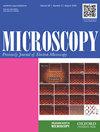镍二十面体和截头八面体纳米晶体在SrTiO3(111)载体上的自组装
IF 1.8
4区 工程技术
引用次数: 0
摘要
镍纳米晶体由于其铁磁性而受到广泛关注。晶体性质在很大程度上取决于它们的晶面,因此详细研究它们的形态、晶面和取向对于磁性应用至关重要。本文利用扫描隧道显微镜研究了室温和超高真空条件下钛酸锶(SrTiO3)(111)端上自组装镍纳米晶体的平衡晶体形状。在超高压条件下溅射SrTiO3(111)衬底(0.5 keV,2.5µA,10分钟)并退火(900°C,1小时)。观察到三种不同的周期:2.21 ± 0.01nm对应于(4 × 4) 重建,3.31 ± 0.02 nm,对应于(6 × 6) 重建和2.85 ± 0.05 nm,相对于(4)旋转30° × 4) 重建,对应(3√3 × 3√3)R30°重建。使用电子束蒸发器将镍(~1 ml)沉积在预热至320°C的基底上,并对样品进行多次后退火。镍呈由(111)个小面组成的支撑二十面体和由(001)和(111)个子面组成的截头八面体的柏拉图形。根据平衡状态下截头八面体的表面能比,计算出粘附功为3.889 ± 0.167焦耳/平方米。本文章由计算机程序翻译,如有差异,请以英文原文为准。
Self-assembly of nickel icosahedrons and truncated octahedral nanocrystals on a SrTiO3 (111) support
Nickel nanocrystals have received much attention for their ferromagnetic properties. The crystal properties are strongly dependent on their facets and therefore detailed study of their morphology, facets and orientation is critical for magnetic applications. In this work, equilibrium crystal shapes of self-assembled nickel nanocrystals on the (111) termination of strontium titanate (SrTiO
3
) at room temperature and under ultra-high vacuum (UHV) conditions have been investigated using scanning tunneling microscope. SrTiO
3
(111) substrate was sputtered (0.5 keV, 2.5 µA, 10 min) and annealed (900°C, 1 h) under UHV conditions. Three different periodicities were observed: 2.21 ± 0.01 nm corresponding to (4 × 4) reconstruction, 3.31 ± 0.02 nm corresponding to (6 × 6) reconstruction and 2.85 ± 0.05 nm, rotated at 30° with respect to (4 × 4) reconstruction, corresponding to (3√3 × 3√3)R30° reconstruction. Nickel (∼1 ml) was deposited using an e-beam evaporator on the substrate preheated to 320°C and the sample was post-annealed multiple times. Nickel took platonic shapes of supported icosahedron comprising of (111) facets and truncated octahedron comprising of (001) and (111) facets. Based on surface energy ratios of truncated octahedrons at equilibrium, the work of adhesion was calculated to be 3.889 ± 0.167 J/m
2
.
求助全文
通过发布文献求助,成功后即可免费获取论文全文。
去求助
来源期刊

Microscopy
工程技术-显微镜技术
自引率
11.10%
发文量
0
审稿时长
>12 weeks
期刊介绍:
Microscopy, previously Journal of Electron Microscopy, promotes research combined with any type of microscopy techniques, applied in life and material sciences. Microscopy is the official journal of the Japanese Society of Microscopy.
 求助内容:
求助内容: 应助结果提醒方式:
应助结果提醒方式:


